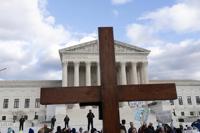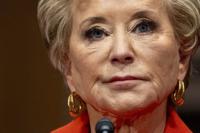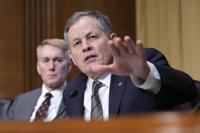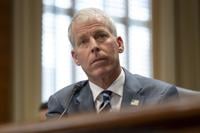A year ago, anti-abortion activists from across the U.S. gathered for their annual March for Life with reason to celebrate: It was their first march since the Supreme Court, seven months earlier, had overturned the nationwide right to abortion.
At this year’s march, on Friday, the mood will be very different — reflecting formidable challenges that lie ahead in this election year.
“We have undeniable evidence of victory — lives being saved,” said John Seago, president of Texas Right to Life. “But there is also a realization of the significant hurdles that our movement has right now in the public conversation.”
Participants at the march in Washington will salute the on abortion throughout pregnancy. They will proclaim that thousands of babies have been born who otherwise might have been aborted, even as the total number of abortions provided in the U.S. rose slightly in the year after that enforcement began.
Moreover, anti-abortion leaders know that their side has a seven-state losing streak in votes on abortion-related ballot measures. Even in red states such as , Kansas and , the outcomes favored keeping abortion access legal.
In this year’s election, several more states are expected to have , and Democratic candidates in many races, including , will be highlighting their support for abortion access.
“We have been around for more than 50 years, and I don’t know of any year that was easy,” said Carol Tobias, president of the ��ɫtv Right to Life Committee.
“But it definitely got harder after Dobbs,” she added. “We have a lot of work ahead of us.”
Tobias was referring to the Supreme Court’s Dobbs v. Jackson Women’s Health Organization ruling in June 2022, overturning the 1973 Roe v. Wade decision that legalized abortion nationwide.
The key consequence of Dobbs was to return decision-making on abortion policy to individual states. Some Democratic-governed states — such as California, and — have strengthened protections for abortion access. Roughly 20 states with Republican-controlled legislatures have either banned abortion or sought to impose new restrictions.
After Dobbs, “I didn’t want anyone to get the false sense that we were at the end of our work,” said Brent Leatherwood, an abortion opponent who heads the Southern Baptist Convention’s public policy wing.
“We’ve gone from a focal point at the federal level to 50 different focal points,” he said. “It may be another 50 years before we truly establish a culture of life, where preborn lives are saved and mothers are supported.”
Even the current claims of lives being saved due to the Dobbs decision are subject to question. While abortions have decreased to nearly zero in states with total bans, they have increased elsewhere – notably in states such as Illinois, Florida and New Mexico, which are near those with more restrictions.
Anti-abortion leaders are keenly aware that their opponents in the abortion debate depict the wave of state bans as an infringement on women’s rights and a potential danger to their health.
Thus the theme of this year’s March for Life strives to convey support for women facing unexpected pregnancies: “Pro Life: With Every Woman, For Every Child.”
“ and maternity homes are the very backbone of our movement,” March for Life president Jeanne Mancini wrote in a recent opinion piece.
She and her allies have encouraged states to offer support programs for new mothers in need — helping them find housing, jobs and health insurance.
Among the scheduled speakers at the march is Jean Marie Davis, executive director of Branches Pregnancy Resource Center in Brattleboro, Vermont. Davis says a similar center in New Hampshire helped her break free several years ago after she became pregnant while ensnared in a sex-trafficking operation.
Other scheduled speakers include House Speaker Mike Johnson, R-La., and U.S. Rep. Chris Smith, R-N.J., a co-chair of the Congressional Pro-Life Caucus.
Mancini said last year’s march drew tens of thousands of people; she’s hoping this year’s march will be bigger.
The participants, she said, will be in a “persevering mood.”
J.J. Straight, part of an American Civil Liberties Union team working to protect and broaden abortion access, says her side also feels determined, especially in light of the recent ballot-measure results.
“We’ve seen a tremendous pushback to the anti-abortion agenda,” she said. “There’s a huge coalition of folks, regardless of their party and other demographics, who absolutely draw the line at this kind interference in their health care.”
Among the reasons for uncertainty for all parties in the debate is the inconsistent way that have adjudicated abortion-related cases. There have been numerous legal challenges to the various state laws banning or restricting abortion, some failing and others succeeding at least temporarily.
There’s a in Texas filed by women who say the state’s abortion ban forced them to continue pregnancies despite serious risk to their health.
In an even higher profile Texas case, , a mother of two, sought an abortion after learning the baby she was carrying had a fatal genetic condition. Her request for an exemption from Texas’ ban — one of the country’s strictest — was denied by the state Supreme Court, and Cox left Texas to seek an abortion elsewhere.
For abortion-rights activists, Cox’s case was a powerful illustration of how abortion bans could be dangerous for women with pregnancy complications.
“Never in our history have we had such overwhelming reaction to any case,” said Nancy Northup, president of the Center for Reproductive Rights. “We got phone calls, emails, snail-mail. Over and over, people talked about her with awe, her courage in going public.”
Seago, the Texas Right to Life president, defended Texas’ abortion ban. He said the Cox case and the pending lawsuit simply underscored the need for Texas health authorities to clarify what doctors are and aren’t allowed to do in dealing with problem pregnancies.
Carol Tobias acknowledged there can be difficult pregnancies.
“But I don’t think hard circumstances should be used to establish state laws,” she said. In such cases, she added, “the doctors have two patients. They need to take care of both of them to best of their ability.”
All the new bans make an exception to allow abortion if deemed necessary to save the life of the mother. There are divides within the anti-abortion movement over additional exceptions — for example, in cases of rape and incest, or when severe fetal abnormalities are diagnosed.
Other divisions have surfaced over who should be criminalized by the new laws.
Among leading anti-abortion activists, there’s a general consensus that women should not be prosecuted for seeking or obtaining an abortion. But there is support for criminal penalties against doctors and others who help people get an abortion; some states, including Texas and , seek to deter people from traveling out of state to get abortions or obtaining abortion pills by mail.
Dr. Jamila Perritt, an abortion-rights supporter who is president of Physicians for Reproductive Health, worries that abortion opponents in states with bans will criminalize people who seek abortions outside the formal medical system.
“The impact of their campaign has been devastating — and it will get worse,” she said. “I’m worried about many more people being arrested and prosecuted.”
One of the biggest unknowns, heading toward to Election Day on Nov. 5, is how power in Washington will be divided between the two major parties.
Abortion-rights supporters fear a Republican sweep of Congress and the White House might trigger a bid to impose a federal abortion ban. Conversely, some abortion opponents — including Chris Smith — fear a Democratic sweep might lead to a law overriding the state abortion bans that are now in effect.
Such legislation — as modeled in the unsuccessful of 2021-22 — would be “an existential threat,” Smith said.
, R-S.C., has introduced a bill proposing to ban most abortions nationwide after 15 weeks of gestation. SBA Pro-Life America, a prominent anti-abortion group, supports the bill, according to its state policy director, Katie Glenn Daniel. But the measure has vehement critics on both sides of the abortion divide.










































